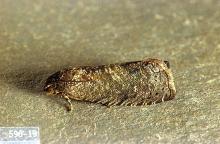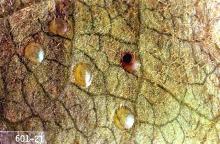Aspila (Grapholita) molesta
Pest description and crop damage Adult is a grayish-brown moth with a wingspan of 0.5 inch. Larvae are creamy white to pinkish caterpillars with black heads and black shields on the thorax and last body segment. Their length ranges from 0.06 to 0.5 inch depending on larval stage. Larvae bore and tunnel into shoot terminals, causing leaves and terminal to wilt and die. Larvae may bore into fruit, tunnel, and feed on flesh. Distribution of this pest appears to be spotty here in the Pacific Northwest with isolated populations found primarily in neglected backyard fruit trees. This insect has not been a problem in Oregon orchards for several years.
Biology and life history This insect overwinters as fully grown larvae in a hibernacula enclosed in silk webbing on ground cover or tree crevices. In spring, pupation occurs, and adults appear near bloom. Eggs are laid on foliage and the larvae feed by boring into the growing shoots. There may be 3-4 generations per year. Later generations also attack fruit before seeking overwintering sites.
Pest monitoring In fruit trees with a confirmed history of Oriental fruit moth infestations, scout for larvae and wilted leaves on shoot and twig tips in early spring. Monitoring traps baited with Oriental fruit moth pheromone can be used to detect the absence/presence of this pest in your area and can help better time pesticide applications.
Management-chemical control
Spray applications and pesticide residues must be well-timed to contact the newly hatched larvae before they bore into the shoot or fruit. For trees with a history of Oriental fruit moth problems, direct cover sprays around the petal fall toward the first generation of larvae. Further spray applications in summer may be unnecessary if the first generation has been effectively controlled.
Pheromone mating disruption works best in large orchard blocks and is not considered an effective option for backyard fruit trees.
Management-chemical control: HOME USE
Warning: Many pesticides are hazardous to bees. Look for bee precautionary statements on product labels and do not use these products during bloom or if bees are foraging in the orchard.
- azadirachtin-Some formulations are OMRI-listed for organic use.
- carbaryl-Highly toxic to bees.
- gamma-cyhalothrin-Highly toxic to bees.
- kaolin-When sprayed on leaves, trunks, and fruit, kaolin acts as a repellant to some insects. Some formulations are OMRI-listed for organic use.
- lambda-cyhalothrin-Highly toxic to bees.
- malathion-Highly toxic to bees.
- pyrethrins-Highly toxic to bees. Some formulations are OMRI-listed for organic use.
- spinosad-Some formulations are OMRI-listed for organic use.
- zeta-cypermethrin-Highly toxic to bees.
Management-chemical control: COMMERCIAL USE
Petal fall application
- Isomate-OFM/PTB TT at 100 to 200 dispensers/A. These dispensers release a synthetic insect pheromone that disrupts insect mating. Dispensers must be placed in the orchard before adult mating and egg-laying flights begin in spring. Scouting and monitoring are necessary to use the product effectively.
Spring and summer spray
Warning: These products are toxic to bees. Do not use them during bloom or when bees are foraging in the orchard.
- chlorantraniliprole (Altacor 35 WDG) at 4.5 oz/A (0.099 lb ai/A). REI 4 hr. PHI 10 days.
- methoxyfenozide (Intrepid 2F) at 10 to 16 fl oz/A. REI 4 hr. PHI 7 days.
- phosmet (Imidan 70W) at 0.75 to 1 lb/100 gal water (4.25 lb/A). REI 7 days. PHI 14 days. Extremely toxic to fish; avoid spray drift and surface runoff.
- spinetoram (Delegate 25WG) at 6 to 7 oz/A. REI 4 hr. PHI 14 days.
- spinosad (Entrust 80W) at 0.4 to 0.8 oz/100 gal water (1.25 to 2.5 oz/A). REI 4 hr. PHI 14 days. OMRI-listed for organic use. May act slowly.





